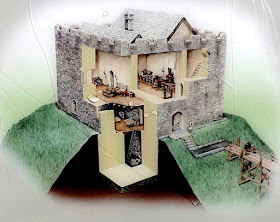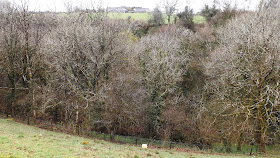 |
| A Viking attack under way much as would have been seen at Lydford in 997 AD |
Battlefields in Devon - Battle of Bindon
Battlefields in Devon - Battle of Bovey Heath
In 997 the King of Wessex was Aethelred the Unready which gives a bit of a clue as to how good a king this chap was. The 'unready' bit would better translate from the Anglo-Saxon into 'bad-council', but either way poor old Aethelred doesn't score high in the charts of great Anglo-Saxon kings.
 |
| King Aethelred the Unready |
Following a comparatively peaceful interval in the mid tenth century after King Edgar, Aethelred's father's conquest of the former Danelaw territory, the English coastline once again became the target of Viking raiders in 980 with Devon and Cornwall being directly attacked in 981 and again later in 988 when it is recorded that the Vikings were brought to battle by the Thegns of Devon.
In August 991 events took another twist with the Saxon defeat by a large Viking force at the Battle of Maldon in Essex and later that year Aethelred agreed to paying 10,000 pounds of gold as tribute to buy off the raiders.
The attempt at paying the protection monies and the apparent weakness of Aethelred's regime only seems to have encouraged the Vikings to push for more easy pickings and the raids continued into the late 900's despite various treaties and payments.
Thus it was in 997 that the Vikings returned to Devon in late summer, possibly led by Swein Harroldson using their classic strategy of swift fast movement inland, to gather as much plunder and booty as they could before dashing back to their boats before they could be intercepted by the local militia or fyrd who would be summoned to the defence.
The Danes landed in the Tamar valley on the county border between Devon and Cornwall catching the locals along the river by surprise and pillaging the length of the valley with all its summer crops and fattening livestock, as they made their way inland.
The defences against this kind of attack was based on those established a century earlier by Alfred the Great and as soon as the alarm was raised villagers began to abandon their homes moving their livestock and goods toward the nearest fortified town or burgh as it was known. The burgh protecting the Tamar Valley was Lydford.
 |
| The famous Lydford Gorge pictured at Point 1 |
The town of Lydford is positioned on a steep sided hill beside the River Lyd and another small tributary. The two sides of the hill down to the two water courses are sheer and steep, forming a natural barrier to attack and with the third side covered by a steep earth embankment and ditch topped by a wooden rampart, Lydford was a formidable fortress.
By the time the Vikings arrived before the town defences, it was crammed with refugees and the wall was bristling with fyrd armed and ready to defend it.
 |
| The Lydford Battle Memorial Point 2 |
As well as its Viking battle, Lydford can boast a display of archaeology that covers the early medieval history of England, from the late Anglo Saxon period through to the Norman occupation and the establishment of the new Norman aristocracy.
A classic example greets the visitor at the centre of the town with the remains of Lydford Castle or as it should be more correctly referred to, Lydford Court House and Prison, for which this tower was built in 1195 and later enlarged by Richard, Earl of Cornwall (1209-1272) who was granted the manor of Lydford and the forest of Dartmoor by his brother, King Henry III, in 1238. He added two stories to the building and heaped the earth around it to create the appearance of a motte, turning the lower floor into a dungeon.
 |
| The prison and courthouse as it may have looked around 1370 |
These taxes generated a lot of wealth for Richard funding his rebuilding project and turning him into the richest man in England able to lend money to his brother King Henry.
 |
| Lydford Castle built in 1195 seen from Point 2 |
Lydford Castle earned a reputation for rough justice and a terrible place to be imprisoned, as the following poem from 1640 illustrates:
"I oft have heard of Lydford law,
How in the morn they hang and draw,
And sit in judgement after."
And Richard Strode an imprisoned MP described the place in 1510 as
"one of the most annoious, contagious and detestable places wythen this realme."
It seems they valued the deterrence factor of prison in 1510!
 |
| The view towards the north western ramparts from Lydford Castle at Point 4 |
 |
| The view of the medieval church from the castle with the Norman defences beyond |
 |
| Carolyn on her way to explore the dungeon in Lydford Castle |
 |
| One of the original arrow slits, the arched windows being a Tudor addition |
Beyond the church in the western corner of the burgh lie the remains of the earliest signs of the arrival of the Normans and it makes sense that they would have quickly identified the town as an excellent place to establish a garrison and head quarters to oversee the local area from.
Along the path towards the Norman ringwork we stooped to admire the replica Viking runestone placed by a more peaceful group of representatives from Scandinavia commemorating the 1000th anniversary of the battle.
 |
| A replica Viking runestone placed by the men of Scandinavia, commemorating the 1000th anniversary of the battle |
 |
| Carolyn gives a sense of scale next to the remains of the bank seen at Point A on the map of the Norman Castle remains |
 |
| The ditch in front of the Norman works seen from Point A |
 |
| Lydfords natural position with steep slopes around the town make it a formidable place to build a stronghold. Seen from Point B |
 |
| The interior of the Norman ringwork seen from Point C |
 |
| View of the ditch in front of the Norman keep as seen from Point D |
 |
| My beautiful assistant providing a sense of scale in front of the ditch at Point D |
 |
| The local pub right next to the castle and suitably named. |
 |
| The remains of the Saxon embankment, Point 5 on the main map |
 |
| This is the place where the Viking attack is thought to have gone in against the Saxon defences at Lydford |
 |
| 10th Century Viking Warriors |
 |
| The view on top of the Saxon embankment towards the Viking lines from Point 5 |
 |
| This area as the point of attack makes sense as it is the only really level piece of ground around the whole circumference of the Burgh. |
Despite a likely fusillade of javelins and throwing axes followed up by Vikings desperately attempting to get a foothold atop the wall, the attack was beaten off and the invaders concern of being caught inland away from their boats and any chance of escape overcame their desire for the booty and plunder that lay behind the walls of Lydford.
 |
| The English Heritage sign illustrates the look of the Saxon defences close to the ancient spring restored by the Lydford Parish Council in 2008 |
 |
| My beautiful assistant and as a Devon Maid standing in for the Saxon Maid seen in the illustration |
 |
| The lane into the town leading up from the spring at Point 7 on the main map |
 |
| A quick detour to Tavistock to plunder and destroy the monastery |
 |
| The spring was in full flow on the day with all the rain water flowing off of Dartmoor |
 |
| Another stream close to the spring carrying water off the moor |
Sadly the nearby bookshop was lacking in any books on the Vikings at Lydford which is surprising seeing how cool Vikings are today following all their TV shows recently and considering the monuments to the history to be found in the town.
Other Sources consulted in this post
Battlefield Walks Devon - Rupert Mathews






Never heard of the battle of Lydford mate, despite having been there several times. Mind you, there were no displays when I went there.
ReplyDeleteVince
There you go Vince, that's what JJ's is all about; to educate, to inform and to entertain.
DeleteTo be honest there are a lot of battles in the county that I have only just become aware of after reading Rupert Mathews book, and now we have a new one up at Northam with the discovery of the battle that followed up Hastings with Harold's brothers turning up for another go.
There is a lot of fun to be had wondering about Devon and looking at battle sites at the same time - recommended!
I loved that shot of the pub.... Church, castle keep and pub all in the same shot... Quintisentially British!
ReplyDeleteI miss a lot about England - pubs and castles being high on the list behind family and old friends...
Another great post - thank you
Thanks Nigel,my pleasure.
DeleteAh yes the curse of the 'ex-pat'. Devon is spoilt for quaint little villages with characterful pubs often as old as or older than the battle sites nearby. I really get a sense of continuity visiting these places imagining my predecessors in centuries past being equally attracted to a welcoming inn.
Glad you enjoyed the views of old Albion.
Great post. Quite a fun read. I agree with Nigel about the castle and pub photo, really cool. Never been to England but when I make it over there this is another place I'd like to visit. Thanks for sharing.
ReplyDeleteHi Adam, thank you. Well when you get to England make a point of visiting "God's own county and country" as Devon has a habit of causing people to keep coming back and some of us stay.
DeleteCheers
JJ